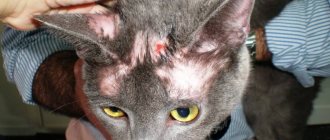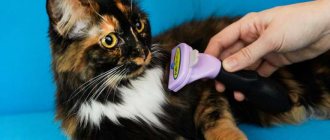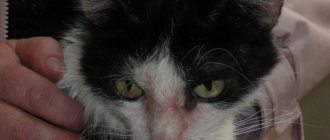Learn how to properly euthanize cats to ensure that it is painless for the animal. euthanize a pet at home
Indications for euthanasia of a cat
Euthanasia is the intentional infliction of death on a seriously ill, suffering animal or person. Translated from Greek, the term means “good death” and quite accurately describes this painless way of dying. Typically, euthanasia of cats is carried out in the presence of an incurable disease, when there is no way to alleviate the suffering of the pet.
Sometimes euthanasia is resorted to without medical indications (bad character, aggressiveness). In our country there are no documents regulating this procedure, and the fate of the pet depends entirely on the will of its owner. It is impossible to prohibit the owner from euthanizing for reasons unrelated to the health of the animal, although from a moral point of view it raises questions.
In veterinary practice, there is only one disease in the presence of which a cat must be euthanized - rabies. It is contagious, transmitted from animals to humans, cannot be treated and leads to the rapid death of the sick person. Characteristic symptoms of the disease are lack of appetite, aggression or apathy, excessive drooling, fear of water, increased sensitivity to light, convulsions.
Euthanasia of a cat for medical reasons is carried out in the following cases:
- terminal stage cancer;
- severe injuries incompatible with life (fall from height, collision with a car);
- serious congenital pathologies in kittens;
- significant deterioration in quality of life due to old age;
- staying in a long coma;
- decompensated chronic diseases of the lungs, heart, liver, kidneys.
When is euthanasia necessary?
Some cat owners are of the opinion that euthanasia is a crime. Others consider it quite humane. After all, if an animal is suffering and it is impossible to help it, then it is better to save it from suffering through euthanasia. Naturally, no sane veterinarian will carry out the procedure of euthanizing a cat unless there is a compelling reason to do so. Euthanasia is a last resort. And they resort to it only in emergency situations.
Euthanasia is necessary if the animal has:
- Incurable disease.
- Zooanthroposis. This is a dangerous infection that leads to death. For example, foot and mouth disease, anthrax, tuberculosis, leptospirosis, trypanosomiasis, etc. This also includes rabies in cats.
- Oncology.
- Fatal injury.
- Congenital pathology that is incompatible with life.
Types of sleeping pills for cats and their effects
According to the form of release, sleeping pills for cats can be divided into two main types: homeopathic and medical.
Homeopathic sleeping pills are various types of herbal infusions, as well as some tablets. Preparations of this type of sleeping pills do not differ in terms of duration and strength of action. This group of sleeping pills is the main and only one.
Medical pills include both tablets and drugs that were developed in medical laboratories. In addition, this group of drugs can be divided into three subgroups.
Medicines are:
- Short term. They are used during various short transportations of the animal, in situations of increased excitability of cats, as well as for sleep disorders.
- Long-term medications are prescribed only by a veterinarian because they treat more serious symptoms. In addition, this group of sleeping pills is often used to prepare an animal for anesthesia. Long-term sleeping pills are used for a short period of time, as they can cause addiction in the animal.
- Sleeping pills of a special group are used only under the supervision of a veterinarian; this group of medications is classified as potent. It is used in animals as a powerful sleeping pill, anesthesia, and also a strong pain reliever.
Use of lidocaine solution in cats
Lidocaine, also known as Xylocaine®
, is an anesthetic used in cats to treat abnormal heart rhythms or cardiac arrhythmias. It is also used as a local anesthetic, such as numbing the skin for suturing.
An anesthetic is a medicine that prevents sensations such as pain. Local or regional anesthesia prevents pain in a limited area or specific area of the body. In contrast, general anesthesia prevents pain, but also causes loss of consciousness and general muscle relaxation.
Lidocaine is a local anesthetic commonly used in veterinary procedures to provide local or regional anesthesia.
Lidocaine is also an antiarrhythmic drug that prevents or treats certain heart rhythm problems. Lidocaine works by preventing the activity of nerve or cardiac cell membranes. By blocking the entry of sodium ions, the cell cannot transmit messages from cell to cell.
Lidocaine is an effective and strong local anesthetic and also works in cats. It may be mixed with epinephrine to maximize the anesthetic effect. Adrenaline constricts blood vessels, allowing lidocaine to remain in local tissues. However, lidocaine with epinephrine should never be used to control heart rate in cats.
Lidocaine is a prescription drug and can only be obtained from a veterinarian or with a prescription from a veterinarian. This medicine is approved for use in animals, including cats.
Veterinarians legally prescribe it as an unlabeled drug.
How to decide on euthanasia?
Deciding to euthanasia is always difficult, because with his decision the owner ends the life of a pet, and not everyone is capable of taking on such responsibility. You need to make sure that the diagnosis is correct. If there is even the slightest doubt, it is advisable to contact several specialists - the possibility of a medical error always exists. Another veterinarian may be able to suggest a treatment option that offers a chance of recovery or at least improvement.
If experts are unanimous, the pet can no longer be helped and is experiencing terrible suffering, euthanasia is a humane way to alleviate its fate. If a veterinarian advises euthanizing a cat, it means that its death is inevitable, and therefore helping it pass away easily and painlessly is the right decision.
Difficult choice problem
The question of whether a cat can take lidocaine is one of the most controversial. Review folders of veterinary clinics and specialized forums are filled with terrible stories about the death of animals after the use of lidocaine. At the same time, almost as often there are references to the absence of a pathological reaction to this drug in caudate patients, and veterinarians sometimes recommend diluting antibiotic powder (for example, Ceftriaxone) with a 2% solution of Lidocaine.
© shutterstock
Proponents of the use of lidocaine are usually confident that severe consequences are the result of exceeding the dosage or using the drug in too high a concentration.
The conclusion from what has been said is simple. There is great individual variation in the response of cats to lidocaine. In addition, this drug often causes severe allergic reactions, even in humans. Therefore, its use in cats should be avoided if possible. Only a doctor can authorize its use, and he must carefully determine the dose and be sure to inject the drug himself.
It's hard to be a god
Euthanasia or “happy death” (from the Greek eữ - good and thanatos - death) is the termination of life in order to get rid of pain and suffering. We all want to give our cat every chance at life, but at the same time we don't want her to suffer. But how can you understand whether your pet has really reached his last hour or whether he still has the opportunity to move away from the “abyss”?
~ unfavorable prognosis (incurable disease with deterioration of condition, which is accompanied by physical suffering), based on the opinion of qualified doctors (!);
~ quality of life As long as the animal does not refuse food, communicates with its owners, and shows at least some interest in what is happening around it, it must live. But if life no longer brings him anything but torment, is it worth prolonging such an existence?
This is your animal, no one knows it better than you, and it is you who bears the responsibility of choosing between its life and death. It's up to you and only you to decide.
Lidocaine Dosing Information for Cats
Medications should never be administered without first consulting a veterinarian.
For topical and topical anesthesia, lidocaine is prescribed until the desired effect, numbness, is achieved. For cardiac arrhythmias, an initial dose of 0.5 to 1 mg/kg is given intravenously followed by a continuous intravenous infusion (IV drip) of (5 to 20 mg/kg). kg) per minute. Doses in cats are typically one-fourth the dose in dogs and must be administered very slowly.
After some time, the animal is slowly weaned off the lidocaine infusion. An ECG helps determine whether the arrhythmias have been corrected or whether more lidocaine or another antiarrhythmic drug needs to be given. Multimodal lidocaine analgesia is widely used in cats. The dose of the drug is 20-50 mcg/kg/minute. This dose gives a pronounced analgesic effect. Lidocaine toxicity in cats occurs through overdose or accidental intravenous ingestion.
What is the procedure like at a veterinary clinic?
Euthanasia of a cat in a veterinary clinic is carried out in several stages:
- Signing by the owner of a consent to euthanize his pet, indicating the reason.
- Introducing the patient into anesthesia. After the sedative is administered, the animal falls into deep sleep. It continues to breathe, its heart beats, but the nervous system is switched off, it does not feel pain and does not react to external stimuli. At this stage, you usually say goodbye to your pet.
- Administration of drugs leading to blocking of the respiratory center and cardiac arrest. For humanitarian reasons, the owner is taken out of the office.
Some veterinary clinics administer a lethal injection without putting the animal into a narcotic sleep. This method is not the most humane, since the cat is conscious and experiencing suffering (feels pain, suffocation, panic). Before carrying out the procedure, you need to clarify how it is carried out in a particular clinic, and if necessary, insist on a preliminary introduction to anesthesia.
How cats are euthanized in veterinary clinics
In euthanasia, the animal is first euthanized. It's a kind of anesthesia. The cat is injected with a drug that affects the central nervous system, turning it off. In a state of anesthesia, the animal stops feeling anything (and it is no longer in pain). This process can also be reversible (recovery from anesthesia), it all depends on the dose of the drug. However, small doses of sleeping pills are used during surgical operations. And during euthanasia, doses are used that can turn off the brain completely. In this state, the animal still has a heartbeat and breathing, but there is no longer consciousness.
The owner can say goodbye to his beloved pet even before the animal is put under anesthesia
The state the cat is in after the first part of the procedure is called vegetative coma. You can take one last look at your pet. After this, the veterinarians will ask you to go out into the corridor. This is done for humanitarian reasons. After some time (about 20 minutes), the veterinarian administers the second drug. Gradually, the animal's heart slows down and stops. When all vital signs are zero, the veterinarian will inform the owner that the animal has died.
I have never had to euthanize my pets, for which I am very grateful. But I know people who are less fortunate. When such a decision has to be made, the owner is tormented by remorse. And sometimes some time after euthanasia. I believe that a loving owner should feel whether he is mentally ready and whether he has said goodbye to the animal. And if the desire to alleviate suffering is stronger than self-pity, then you can decide.
There is also a less humane way of euthanasia. It involves the use of drugs that forcibly stop the functioning of the heart and lungs. In this case, the animal can “beat” in agony. Therefore, a person must first clarify which method and which drugs are used in the chosen clinic.
Which drugs can be used and which are prohibited?
Some drugs are not recommended for euthanasia of pets
Some clinics (and sometimes the owners themselves) choose non-recommended drugs based on financial capabilities. Some drugs are simply difficult to obtain. There are also means that are used for euthanasia, despite the fact that they are not recommended by most international animal protection organizations. For example, dithiline (listenol, adiline, succinylcholine, suxamethonium) can be used. The use of ditilin will lead to the death torment of the animal. Therefore, you need to either refrain from using it, or require the cat to be placed in a state of vegetative coma.
When I was researching various euthanasia drugs, a browser search brought up a drug such as T-61. This means that the Russians are resorting to using it. Although officially it is used only in some European countries: Germany, Czech Republic, Belarus, Slovenia and Italy.
T-61 includes a number of active substances:
- embutramide;
- tetracaine hydrochloride;
- Mebesonium iodide.
This drug is administered intracardially or intrapulmonarily, so in some countries its use is considered a cruel method of killing. The World Society for the Protection of Animals recommends using T-61 only as a second stage of euthanasia. According to society's recommendations, it should be administered with (or after) a strong dose of sleeping pills.
Every city has a public organization that works with animals (you can ask volunteers for advice on choosing a drug)
The following drugs are allowed in the Russian Federation:
- Xylazine (rometar, xylanit, xyla) can be used in combination with other drugs.
- Zoletil consists of tiletamine (an anesthetic) and zolazepam (a muscle relaxant), and can be used with other drugs (for example, xylazine).
- Barbiturates: sodium thiopental, pentobarbital, hexenal, phenobarbital, etc.
- Propofol (diprivan) is an anesthetic, short-acting hypnotic, similar in properties to previous drugs.
- Arduan, listenol are muscle relaxants with curare-like action, similar to ditilin. They are used to put people to sleep by stopping breathing. Can be used only after the animal’s consciousness has been switched off.
- Lidocaine is an anesthetic and cardiac depressant. It is used for euthanasia by injection into a vein or heart. The animal must be under anesthesia.
- Magnesium sulfate causes vascular collapse and paralysis of the respiratory center. Similar to previous drugs, it should be used only after anesthesia.
Cost of veterinary euthanasia
Now you have learned how cats are euthanized. If you decide to resort to it, think about where it is better to do it: in a veterinary clinic or at home. The advantages of the home option are obvious: there is no need to add a tedious move to the series of sufferings. In your own walls you can say goodbye to your cat, pet her for the last time and imprint her in your memory.
In Moscow, the price of euthanizing cats in different clinics ranges from 1,500 to 3,500 rubles. The VetCom veterinary service offers more comfortable euthanasia at home. Cost of service: 2500 rub. Please note that the following are paid separately:
- calling a doctor;
- drug anesthesia;
- delivery of the body for cremation.
Animals that live with us side by side for many years remain in our hearts forever. Having done everything possible for them and coming to terms with what happened, we will remember them alive and happy...
Cost of the procedure
The cost of euthanasia varies between 1000-2000 rubles and depends on the following factors:
- size of the settlement (in megacities the price of the service is approximately 30% higher than in small towns);
- veterinary clinic level;
- pet's weight;
- list of services provided (home visits, subsequent cremation, etc.).
Calling a specialist to your home will increase the total cost by an average of 1000-1500 rubles. Sending a deceased cat for cremation will require an additional at least 500 rubles.
Be sure to read:
Do cats understand people: how they recognize them through intonation, gestures and smell, cat telepathy
In many clinics, the price for euthanizing an animal weighing up to 10 kg is fixed. The cost of the procedure for larger animals is negotiable.
Some veterinary hospitals offer lower price lists for euthanasia services. The main criteria when choosing a clinic should not be the amount of material costs, but the professionalism of the doctors and the quality of the drugs used.
Why is it necessary to euthanize your pet at home yourself?
Sometimes owners decide not to contact a veterinarian, but to kill the animal with their own hands at home. Typically, this decision is explained by living in places remote from populated areas and the high cost of the procedure. Putting a pet to sleep at home, much less with your own hands, is not the best option for impressionable owners. This is morally difficult, and besides, the place where the cat passes away will remain a reminder of the loss for a long time, evoking difficult feelings and memories.
If visits to the clinic were regular and the cat treats them calmly, it is better to euthanize it in a hospital.
If an animal experiences extremely painful situations when it has to leave its home, it is better to let it die in a familiar environment, without subjecting it to additional stress from a trip to the clinic.
Options for putting a cat to sleep temporarily
Euthanasia refers to a reversible process, as a result of which the pet falls asleep under the influence of medications, and not on its own. All of them affect certain parts of the brain.
How to clean a cat’s ears at home: options for how and what to wash with
How to put a cat to sleep? Temporary induction of sleep is carried out using:
- Droperidol is a neuroleptic drug from the butyrophenone subgroup, with a sedative and tranquilizing spectrum of action. The drug stops motor activity, relaxes muscles, and is often used in premedication.
- Proforol - a general analgesic effect is achieved by depression of the central nervous system and is produced in the form of an emulsion.
- Proforol is a muscle relaxant classified as a curare-like substance.
- Ditilina - relaxes muscle tissue, slows down the heartbeat and heart function.
- Thiopental - causes a state resembling deep anesthesia.
- Dimetrol - with a hypnotic effect due to central nervous system depression.
- Zolarepam is a pain reliever.
The listed medications are not a complete list of medications used in animal hospitals. Most of them cannot be purchased at a pharmacy without a doctor's prescription.
Important! Sleeping pills for cats cannot be used at will. Incorrect dosage selection will cause serious poisoning, and in difficult cases, death.
Sleeping pill for hair cutting
Before a long trip, moving, getting a haircut or visiting a veterinarian, you can use mild sedatives or homeopathic medications. They are prescribed by a doctor when participating in cat shows or when adding a second animal to the house. Popular sleeping aids for cats for transport that allow them to be easily trimmed include:
Kot Bayun - sleeping pills for cats
- Kot Bayun - produced in tablets and tincture, intended for oral administration. It contains medicinal plants and has a moderate sedative effect.
- Stop Stress - relieves the effects of nervous overload, calms. The mild effect is due to the component composition: mint, motherwort, hops.
- Fitex - calms, normalizes sleep, improves the condition of the nervous system. Made in drops, it contains valerian, motherwort and hops.
Important! Herbal medicines are the best option for a nervous kitten who hasn’t slept for days. They are not addictive with prolonged use.
Reasons for euthanizing a dog
There are reasons why owners decide to euthanize a pet, despite moral principles.
What can serve as a basis for administering a lethal injection:
- The dog becomes very old or is in great distress due to an incurable illness or severe injury.
- Uncontrolled aggressiveness , posing a danger to others.
- Inability to keep an animal.
- Allergy.
- Animal bites.
- Rabies or plague.
Euthanasia may be necessary if infected with rabies.
Indications for cat euthanasia
The grounds for euthanasia are usually:
- incurable diseases that cause suffering to the animal or significant impairment of body functions after illnesses;
- injuries incompatible with life;
- in some cases, the indication is old age.
As for injuries, there are many cases where seemingly hopeless animals that received multiple injuries and serious fractures, for example, having fallen under the wheels of a car, to the surprise of both the owners and the doctors, nevertheless recovered and continued a completely normal existence. No wonder there are sayings: “heals like a cat,” “a cat has two lives,” “tenacious like a cat.” So, you should never rush, and if the animal is dear to you, you need to give it a chance to recover by undergoing the necessary treatment.
In other cases, if the owner of the animal has doubts about whether to euthanize the animal or not, then you should not rely on the opinion of one veterinarian, but it is advisable to visit several specialists from different clinics and only if they are all unanimous that the treatment is not suitable. It makes sense to make the final decision.
After the decision to euthanize is made, the owner needs to prepare emotionally, choose a clinic and method of euthanasia, this is important both for the peace of mind of the owner himself and for an easier fate for the animal.
Pros and cons of euthanizing an animal without the help of a veterinarian
Euthanasing an animal at home without the help of a specialist is associated with a number of difficulties. There is no magic pill that allows you to euthanize an animal easily and painlessly. It is difficult to obtain medications for euthanasia, and even more difficult to calculate the dosage. Most drugs are administered intravenously or intramuscularly. Trying to cope with this task without experience means causing unnecessary suffering to the poor animal.
If you still managed to find a drug that stops the heart, it is unlikely that you will be able to purchase the narcotic drug that turns off consciousness necessary for an easy death. Without it, your pet will die a long and painful death.
Euthanasia of an animal on your own is complicated by the psychological aspect. Giving a cat a lethal injection is morally difficult; in the future, the owner runs the risk of experiencing remorse from the fact that he personally killed the pet, and suffering from difficult memories. The only advantage of self-euthanasia is that it saves money, but you will still have to pay for the removal and cremation of the body.
Share with friends!
Self-euthanasia at home
Doctors often euthanize cats at home.
Euthanasia of an animal requires certain skills and knowledge from a person; the procedure is complex from a psychological point of view. Experts do not recommend carrying it out to a cat owner who does not have experience in such work.
Sometimes people are in a hopeless situation and decide to euthanize their pet on their own for the following reasons:
- financial difficulties;
- a significant distance between the house and the veterinary hospital;
- problems with free time.
However, veterinarians warn that it is not possible to purchase the necessary medications: such medications are issued only to licensed specialists or veterinary clinics.
The use of low-quality analogues can significantly complicate the euthanasia process and cause painful convulsions in the animal. In addition, it is difficult for an inexperienced person to determine the correct dosage of medications. It is absolutely unacceptable to use various poisons for another purpose during euthanasia.
The conclusion of the professionals : it is impossible to euthanize a cat at home without pain for the animal!
Types of tranquilizers and their effects
In the previous section, we already said that sleeping pills are divided into three groups based on the duration of their effect. Let us describe these groups in more detail.
Short term
After taking them, the cat will sleep for 2-3 hours, most often used for transportation, with increased excitability, stress or sleep disorders.
The most effective drugs in this group:
- Xylanite . Available in the form of a solution for injection. Externally it appears as a colorless or light yellow liquid. Has a calming effect on small pets for 1.5 – 2 hours. It also acts as a pain reliever - in this case it acts for 15-30 minutes. The effect occurs on average after half an hour. Xlanit is administered intramuscularly to cats. The dosage is calculated at 0.15 ml per kg of animal weight.
- Intraval . Puts the cat to sleep for no longer than a quarter of an hour. In case of sleep disturbances, it increases its duration. Also used for convulsive seizures. It is introduced into the body intravenously.
- Barbamil . The drug is indicated for surgical interventions or severe stress. It is given to the cat orally. It is advisable to mix the medicine with a treat for the animal. Before use, consultation with a veterinarian is necessary, since the medicine has a number of contraindications.
Medium term
The animal goes to sleep for 4-5 hours. Prescribed for the treatment of serious mental disorders, severe seizures, and also for preparing a cat for sleep.
- Etaminal sodium . The drug is considered harmless to cats, non-toxic. Copes with nervous excitement and stress. The product is addictive, so it should be used with caution.
- Barbital sodium . The animal falls asleep 1.5 hours after administration. The drug is completely eliminated from the body after 10 hours.
- Chloral hydrate . The drug should not be taken by pregnant or lactating cats, as well as pets under six months of age. The drug has an even larger list of contraindications, so its use should begin after consultation with a veterinarian and under his constant supervision.
Long-term
The drugs induce the cat to sleep for 10 hours and are used only during surgical interventions. The drugs are available only by prescription and are used under the supervision of a veterinarian. When using, the dosage must be strictly observed, otherwise the animal may not wake up after sleeping pills.
- Ketamine . In addition to the main effect - a sleeping pill - the drug has an effect on the cardiovascular system: it stimulates the heart, increasing the heart rate and increasing blood pressure. It is administered intramuscularly and intravenously. The medicine should not be used for animals prone to seizures, as well as for procedures that can provoke seizures.
- Ftorotan . It is introduced into the animal's body by inhalation. It must be used with extreme caution, since the wrong dosage can lead to complete cardiac arrest. Anesthesia occurs quickly, without a phase of motor excitation. At the same time, the animal recovers from anesthesia just as quickly.
- Methoxyflurane. The drug is also administered by inhalation. The effect of the drug takes quite a long time, since its components are easily dissolved in lipids. It is used most often when not only a hypnotic effect is needed, but also an analgesic effect.
Important! Medium- and long-term groups of drugs can only be used for a short period, as they are highly addictive.
Sleeping pills are available in tablet form, but are extremely rare. Most often, the medicine is produced in the form of drops or liquid for the preparation of a solution for injection.
Attention! Drugs intended for humans are not suitable for animals, since the concentration of active substances in them is increased by 10-15 times.
Use of lidocaine for cats
Lidocaine is commonly used as a topical and topical anesthetic.
The drug must be administered in close proximity to the wound or operation. It can also be used as an epidural (“spinal”) anesthesia to prevent pain in an area of the body (regional anesthesia).
Lidocaine is also used to treat abnormal heart rhythms or cardiac arrhythmias. The benefits of lidocaine for heart rhythm are generally limited to the treatment of ventricular arrhythmias diagnosed by electrocardiogram (ECG).
What's next?
After euthanasia, the owner once again has to make a choice:
- keep the body for self-burying
- leaving him at the clinic or veterinarian for cremation and further burial is the most common option
- leave for cremation with return of ashes
Cremation is usually common for many animals, in which case you cannot be sure that the ashes returned to you will be those of your pet.
Currently, organizations have emerged that provide funeral services for pets, including: painless euthanasia of the animal, general and individual cremation in the presence of the owner, video recording, distribution of ashes after individual cremation in a special urn, etc.
Some large cities also have official pet cemeteries. Alas, not in all of them.
In the civilized world, the problem of burial has long been solved. Almost every European city has an animal cemetery. There are about 650 specialized burial sites in the United States. The most expensive one, on which the dogs of Charlie Chaplin, Steven Spielberg and other celebrities rest, is located in Los Angeles.
What is the process of euthanizing an animal?
When there is a need to euthanize a cat in a clinic, the cost of the procedure should be the least of the owner’s worries. Here it is much more important to choose a good veterinary hospital where competent specialists work. First, the doctor will examine the animal, make a diagnosis and express an opinion regarding the advisability of the euthanasia procedure. Perhaps the cat can still be cured.
If the doctor, after an examination, agreed to euthanasia, it is better not to rush into carrying out this manipulation. It is worth showing your favorite to several more specialists and hearing their opinion. After all, sometimes one doctor recommends euthanizing, while another can prescribe effective treatment, after which the animal will be cured and live for more than one year. You should fight for the life of your pet to the last. Before you find out how much it costs to euthanize a cat in a veterinary clinic, you should understand how such a procedure is carried out.
Natural death
Some owners believe that their cat should die without assistance. This may be for religious or moral reasons, when people feel that they do not have the right to choose death for their cat, or simply cannot decide to take such a step.
In this case, you should understand that the death of a pet can be either peaceful and calm, or terrible and repulsive. Unfortunately, it is difficult to say for sure whether everything will happen quickly and painlessly, or whether the process will be lengthy and accompanied by terrible torment. In the latter case, the owner will have to witness the suffering of his friend, memories of which can remain in the memory for a long time, causing a feeling of guilt.
This is your animal, your choice and responsibility is also yours.
Let go if you love!
It's hard to decide to take someone's life. And it’s very hard to lose a beloved friend. If everything that can be done has already been done, and the pet has no “taste for life” left, well, perhaps it’s time for a parting gift - to give him the opportunity to fall into a peaceful sleep, leaving pain and suffering behind.
How will I live without him? Of course, pets are a significant part of our lives; a strong emotional connection is established between us, and sometimes it is simply impossible to imagine our existence without them. But this is not a reason to keep your four-legged friend by being selfish. Remember that love is also the ability to let go in time. Let it be a consolation to know that your little friend is no longer suffering.
Temporary euthanization of a pet
This type of euthanasia is used if, for example, hygiene procedures are required. Veterinarians do not recommend using strong anesthetics or barbiturates for this purpose, because this is dangerous. In case of even the smallest overdose, the animal can die. It is better to give preference to sedatives that are available without a prescription. These include Stop-Stress, Cat-Bayun and others. Propofol, Vetranquil and Rothemar are used by veterinarians, but cat owners are better off not touching them so as not to harm the pet.











